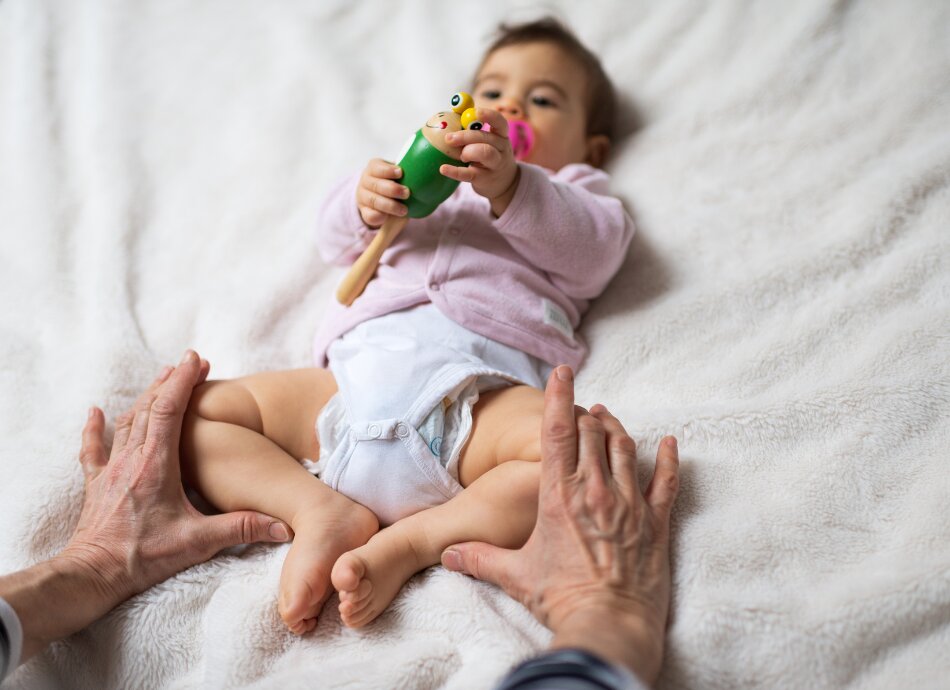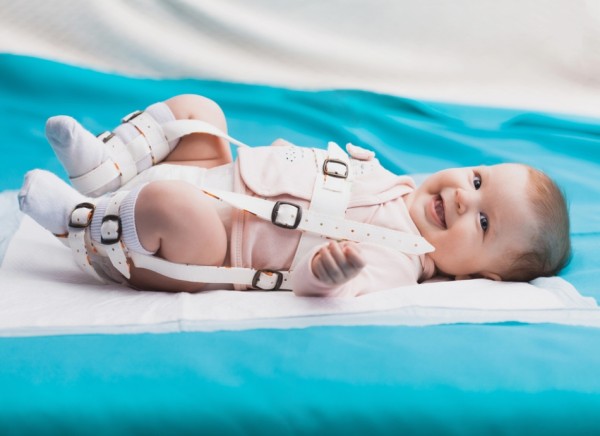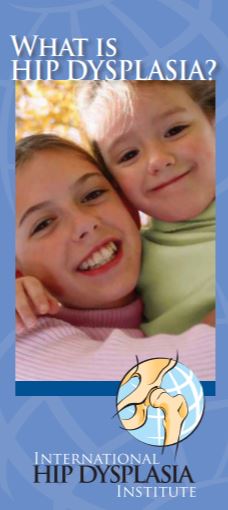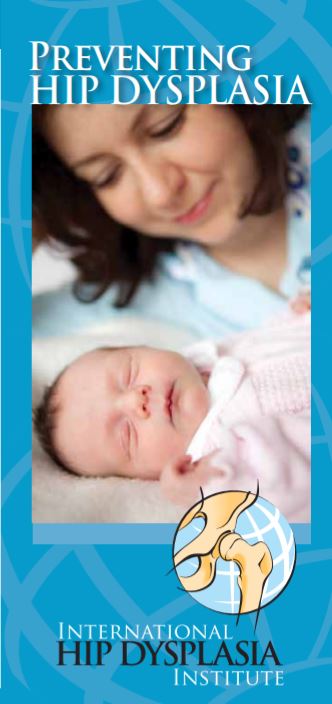Hip dysplasia in babies
Also known as developmental dysplasia of the hip (DDH) or congenital dislocation of the hip
Key points about hip dysplasia in babies
- Developmental hip dysplasia is a condition where the hip joint doesn't form properly or is unstable in babies and young children.
- Of every 1000 babies, 1 to 2 are affected.
- Girls are 5 times more likely to get the condition than boys.
- Hip dysplasia isn’t always detected at birth. It can progress over the first few months after birth.
- Treatment is more effective, and the outcome will be better, if it's found early.
- Practicing hip-healthy swaddling and carrying of your baby can help prevent hip dysplasia and other serious hip problems.

Hip dysplasia in babies is a congenital condition (present at birth) where your baby’s hip joint doesn’t form properly. It might not be found as soon as your baby’s born, but it can get worse during the first few months and is found then.
In babies with hip dysplasia, the ball of the hip joint – the head of the thigh bone (femur) – doesn’t fit snugly into the hip socket. This can lead to instability or dislocation of the hip joint. Untreated it can cause damage to the hip that causes pain and early arthritis later in life.
About 1 to 2 of every 1000 babies is affected by developmental hip dysplasia.
Early detection can mean treatment is simpler and more effective, resulting in better outcomes for your pēpi.
The hip joint is commonly called a ‘ball and socket’ joint. It’s made up of the head of the femur (thigh) bone (the 'ball') and the acetabulum ('socket'), which is a curved dish-like part of your pelvis. For the hip joint to work properly, the head of the femur has to fit into the pelvis socket tightly.
In hip dysplasia, the socket of your baby’s hip joint isn’t deep enough, so the head of the femur (the ball) doesn’t fit properly into it. This causes the hip joint to be loose and means it can dislocate (come out of the socket) easily.
The image below shows a subluxation (partial dislocation) of the hip joint and a full dislocation where the ball has slipped out of the socket.

Image credit: Depositphotos
The exact cause of developmental hip dysplasia isn’t known. However, risk factors for babies getting hip dysplasia include:
- being female
- being a first-born baby
- your baby being in the breech position (feet or bottom first) in the 3 months before birth
- a family history of developmental hip dysplasia.
Symptoms of hip dysplasia in your baby often aren't noticeable, but may include:
- one leg looking shorter than the other
- one leg being less flexible or mobile than the other, or appears to turn outward
- their thigh, buttock or groin creases not being symmetrical (they look different from each other)
- clicking felt in the hip when you change their nappy or dress them
- leaning to one side when they're standing
- your toddler 'waddling', walking with a limp or walking on their toes (if hip dysplasia has not been diagnosed earlier).
Your doctor or midwife will check your baby for this condition when they are born as part of the newborn examination. They will do some tests on your baby by gently moving their hip joints.
If hip dysplasia isn't detected soon after your baby is born, your healthcare provider, midwife or Well Child provider will do more tests over the next few months, including at their 6-week check, to see if they have hip dysplasia.
If your healthcare provider is concerned, they will refer your baby to a paediatric orthopaedic surgeon (a doctor who specialises in treating bone, joint and muscle problems in children). If your baby's hips feel stable when they're examined but there are risk factors for hip dysplasia, or your baby is older than 4 months of age, they may need an X-ray or ultrasound of their hips done first.
The treatment chosen depends on your baby's age and how severe their hip dysplasia is.
Treatment can include:
- observation (watching and waiting), with repeat ultrasound scans and X-rays to monitor your baby’s hips
- a harness, brace, or plaster cast (called a hip spica) – to hold your baby's hips in a stable position
- surgery.
The image below shows a baby wearing a harness.
 Image credit: Depositphotos
Image credit: Depositphotos
Talk to your baby's healthcare provider or surgeon to find out the best treatment option.
To prevent hip dysplasia, make sure your baby's hips are not wrapped (swaddled) tightly with their legs straight and pressed together. To allow healthy hip development, your baby's legs should be able to bend up and out at the hips.

Image credit: Canva
If you use a baby carrier, make sure it supports your baby’s hips appropriately – their thighs should be supported and the hips and knees bent (the ‘M’ position).
Read more about hip-healthy swaddling(external link).
Not all cases of hip dysplasia are the same but most children have good outcomes from treatment and are able to develop normally.
However, if hip dysplasia isn't diagnosed and treated early, it can get worse and cause complications such as:
- your child learning to walk with a limp
- severe hip pain and early arthritis (wear and tear of the lining of the joint)as a young adult
- the need for hip replacement surgery at a young age.
The following links provide further information about developmental hip dysplasia. Be aware that websites from other countries may have information that differs from New Zealand recommendations.
Developmental hip dysplasia(external link) Healthinfo, NZ
Developmental dislocation of the hip (congenital dislocation of the hip)(external link) Starship Paediatric Orthopaedics, NZ
Developmental dysplasia of the hip (DDH)(external link) The Royal Children's Hospital, Melbourne, Australia
Developmental dislocation (dysplasia) of the hip (DDH)(external link) OrthoInfo, US
Developmental dysplasia of the hip(external link) NHS, UK
What is pediatric hip dysplasia?(external link) International Hip Dysplasia Institute, US
Brochures
What is hip dysplasia?(external link) International Hip Dysplasia Institute, USA
Preventing hip dysplasia(external link) International Hip Dysplasia Institute, USA
References
- Developmental dysplasia of the hip (DDH)(external link) Auckland Regional HealthPathways, NZ, updated 2024
- Developmental dysplasia of the hip(external link) Starship Paediatric Orthopaedics, NZ, 2024
Clinical guideline and resources
Developmental dysplasia of the hip(external link) Starship Clinical Guideline, NZ
Resources for pediatric and primary care providers(external link) International Hip Dysplasia Institute, US
Continuing professional development
Pavlik Harness Learning Module with Dr. Kelley (external link)International Hip Dysplasia Institute, US, 2016
Video: How to test for newborn hip dysplasia
Brochures

International Hip Dysplasia Institute, US

International Hip Dysplasia Institute, US
Credits: Healthify editorial team. Healthify is brought to you by Health Navigator Charitable Trust.
Reviewed by: Dr Sara Jayne Pietersen, FRNZCGP, Auckland
Last reviewed:





